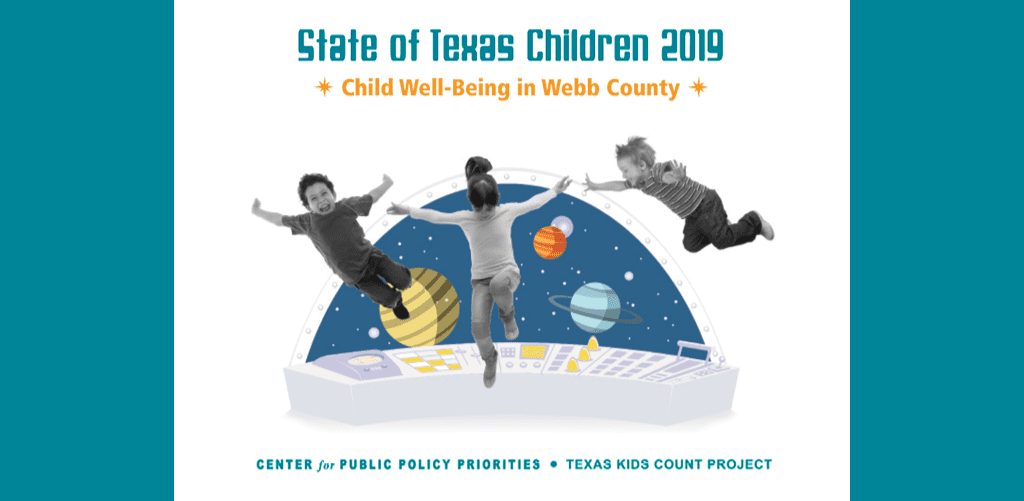If the border economy in Laredo and Webb County is booming, then why are kids in the area facing so many challenges? A new report takes a deep-dive into the data.
Larger cities in the county serve as hubs for international trade and make the South Texas region demographically unique from other parts of Texas. Nearly all children who call Webb County home are Hispanic (96 percent). Of Webb County’s Hispanic children, only four percent are non-citizens.
Despite the county’s vibrant commercial landscape, 36 percent of children in Webb County live in poverty. A startling 70 percent of children live in areas with high-poverty neighborhoods, compared to 17 percent of children statewide. That means these children and their families are less likely to have high-quality doctors, schools, and grocery stores close to home—the very resources they need to grow, learn and thrive.
The good news is that elected leaders can address these inequities through effective public policy. Here’s how they can invest in Webb County’s children.

Help Kids Grow
- Expand Medicaid
Children in Webb County are more likely to lack access to health care than other Texan children. Just like any other growing child, they get sick, need eyeglasses, or rely on medication. However, families in Webb County often can’t afford to see the doctors they need. Health care is especially important in a county where 26 percent of children are not sure they will get their next meal. By allowing more low-income parents to access Medicaid, lawmakers would connect more children to health care, too.
- Improve access to care for pregnant women and new moms
Health care for moms helps ensure that babies get a healthy start in life. Alarmingly, more than 16 percent of women in Webb County received late prenatal care or none at all, which is five percent worse than the state average. It helps explain why moms in Webb are more likely to die during or after childbirth than others across Texas: many are missing the critical services they need to detect and avoid serious problems before they arise.

Help Kids Learn
- Reduce inequities in school funding
School funding can improve equity in our schools and lead to better student outcomes. This is vital for Webb County, where most students qualify for free or reduced-price meals (86 percent). Texas’ new school finance law brings more funding into schools across the state, but it also uses state funds to pay down property taxes, reducing funding available for schools. Unfortunately, this move could increase disparities between wealthier and poorer school districts and undercut the progress our state is making.
- Fully invest in Pre-K
Pre-Kindergarten programs have proven to nurture school readiness, develop social and behavioral skills, and improve student outcomes, but 42 percent of eligible children in Webb County are still missing out on this critical stage of their education. Lawmakers recently increased funding for low-income and English Language Learner students—a huge benefit for kids in counties like Webb. They can build on this progress by designating funds exclusively for full-day pre-K to ensure high-quality programs across the board.

Help Kids Thrive
- Improve wages and benefits
Families in Webb County earn a household income of $45,000 per year or less about $23,000 less on average than Texans across the state earn. Notably, Webb residents with less education are more likely to be employed than those with some higher education. That means more jobs in the region are low-skill, low paying, and lack benefits. By enacting policies to ensure high-quality jobs for parents, lawmakers can reduce the poverty rate among kids.
- Count all kids in Webb County
The nation will conduct its 2020 Census in less than 6 months, which is a count of all people living in the United States. Taken every 10 years, the Census determines representation in Congress as well as the number of federal dollars for each state to spend on health care, housing, education, transportation, and more. All residents, especially kids, need to be counted in order for Webb County to receive federal dollars for programs like the Supplemental Nutrition Assistance Program (SNAP, formerly “food stamps”), the Children’s Health Insurance Program (CHIP), and school lunches. Historically, children are especially hard to count — and far more so if they are non-White, live in poverty, or have immigrant family members still afraid to send information to the government in the wake of the defeated citizenship question. Texas has one chance to get this right. When we count all kids, we ensure they have the resources they need to thrive for the next decade — which is most of their childhoods.
These actions can improve access to health care, education, and economic security: the basic building blocks that children everywhere need to thrive. By investing in kids, our leaders can create a strong foundation for the future of Webb County and the state at large.

State of Texas Children 2019: Child Well-Being in Webb County is part of the State of Texas Children report series of the Kids Count project. Visit the Kids Count Data Center for extensive, in-depth child well- being data for each of Texas’ 254 counties and the seven largest metropolitan areas. This research was funded by Methodist Healthcare Ministries of South Texas, Inc. and the Annie E. Casey Foundation.
Research & Planning Intern Cindy Ji contributed to this post. A version of this blog post may appear as an op-ed in print or online, authored by Jaime Wesolowski, president and CEO of Methodist Healthcare Ministries.
